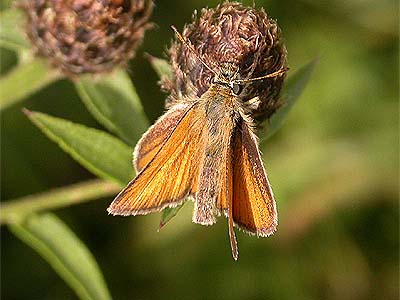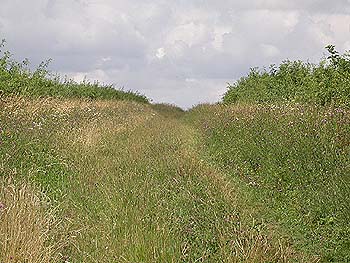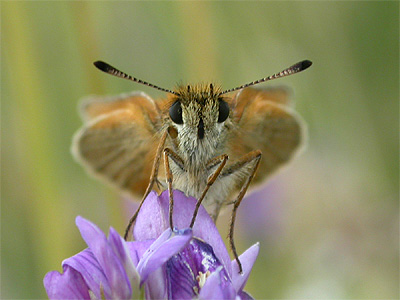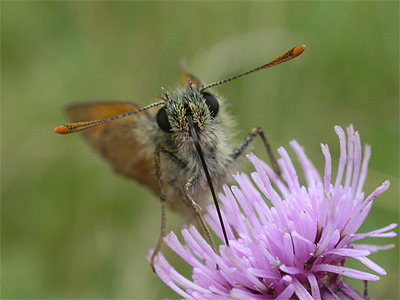

| The Essex Skipper at Eakring | ||
| ... |
 |
Since it's first
appearance at Colwick Country Park in 1995; the Essex
Skipper continued it's northward range expansion through
south-eastern Nottinghamshire during the late 1990's. By 1998, several sites as far north as Cotham, had recorded their first examples, whilst Colwick and Holme Pierrepont, both continued to report the species on an almost annual basis. Because the Essex Skipper is extremely similar to the Small Skipper, it's further spread throughout the county, has probably passed unnoticed. It is extremely under-recorded, but now probably present over much of Nottinghamshire. Like the Brown Argus, the Essex Skipper's rise as a colonist, has come at more or less the same time. Then again, many other butterflies (which were once a very difficult find in Nottinghamshire) have also continued to spread at a terrific rate. |
|
| ... | ||
| During the early 1980's,
species like Comma, Ringlet, Gatekeeper and Speckled
Wood, were all completely unknown to me as
Nottinghamshire species' and the nearest sites for
obtaining each, was in Leicestershire or
Northamptonshire. The 1990's and the opening years of the
new century, have seen the continued spread of all, no
doubt suited by the milder Winters throughout that time. Discovery at Eakring - July 27th 2003 The Essex Skipper was a species which was always likely to occur in the area at some time; and it was discovered near Eakring village whilst searching for another recent (but seemingly only temporary) colonist - the Brown Argus. |
 |
|
| ... | ||
| The discovery
came only a week after the Purple Hairstreak was finally
added to the area's butterfly species list. Described by the Nottinghamshire Wildlife Trust as a "species-rich green lane" and suitably designated as a SINC site, Mill Lane (above) runs west from Eakring village, alongside the Oil Bore Holes site for part of its length. The variety of flora found along it's length is excellent and consequently, provides a useful nectar source for many butterflies and other insects. It was along here, that the Essex Skipper was first noted and numbers appeared quite good. A more thorough survey will take place. |
||
| ... | ||
 |
Confusion with
the Small Skipper The Essex and Small Skipper are difficult to tell apart. Life-cycle differences mean that the Essex Skipper emerges a few weeks later than the Small Skipper (usually around the third week in July) then over-winters in the egg stage with the Small Skipper passing the Winter as a young larva. Larvae of both species feed on a variety of grasses. Structural differences between the two are slight and quite subtle. However, once learnt seperating the two becomes quite easy to the trained eye. The most obvious difference is on the underside of the tips of the antennae - black on Essex Skipper and light-brown on Small Skipper. Above left:- Essex Skipper - the photograph shows the black antennae tips easily |
|
| ... | ||
 |
Below left:-
The Small Skipper - note antennae tip colouration for
comparison Another way of distinguishing the two, lies in the thickness of the line of scent scales on the forewings of the males. In the Essex, this band is much finer and straighter than that of the male Small Skipper, where the scent band draws away from the leading edge of the forewing and towards the body. This band can sometimes be difficult to see clearly on worn adult male Essex Skippers and is always more obvious on male Small Skippers. The general colouration of the upperside of the forewings is usually a much more fulvous brown on the Small Skipper, though this feature is by no means diagnostic, but may provide initial suspicion of identification. Often Essex Skippers can appear worn in comparison. |
|